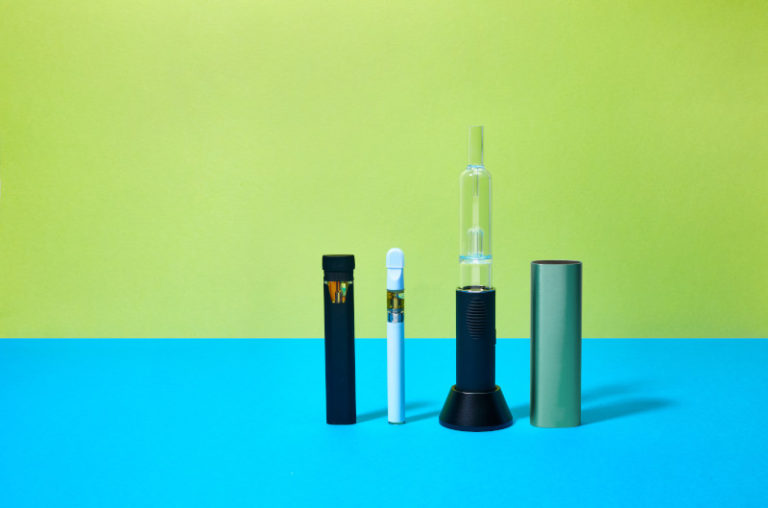There's an old saying that fake gold only exists because of the real thing. In the world of cannabis, the same adage stands. High-quality cannabis, and cannabis products, are now widely available in legal states. But so too are illicit market imitations, particularly counterfeit cartridges.
Purchasing a counterfeit cartridge can carry serious potential repercussions. Unlike fake handbags, counterfeit cannabis carries huge risks for public health.
So, how do you detect counterfeit vape cartridges or avoid falling prey to illicit market hawkers? Fortunately, there are some straightforward ways to get weed wise and separate the wheat from the chaff, or the leaf from the stem, in the world of cannabis.
 Photo by: Gina Coleman/Weedmaps
Photo by: Gina Coleman/WeedmapsImage lightbox

Why are there so many fake vape pens?
According to Winston Peki, cannabis expert and founder of Herbonaut.com, low-quality vape pens are cheap and easy to produce. “Most imitation products are sourced directly from China with little to no regard for quality control,” said Peki. Unaware consumers generally lack the awareness to spot a fake vape cart or e-cigarette — especially if it's sporting a well-known brand name.
“The average consumer can't recognize an imitation vape pen because they would have to test-drive it properly,” noted Peki. With many vape cart users unschooled in the art of distinguishing real from fake, consumers sometimes unwittingly purchase counterfeit vape cartridges, inadvertently fueling the demand for these products.
For Victor Guadagnino, co-founder of Keystone Canna Remedies, a licensed medical marijuana dispensary in Pennsylvania, the presence of counterfeit vape pens underlines the enduring need to standardize the industry. “At the beginning, we did see quite a few circulating the black market as patients would sometimes reference them at the counter,” reflected Guadagnino. “This highlights why uniform regulations are so crucial for the development and standardization of the cannabis industry.” Guadagnino noted, however, that the maturing of Pennsylvania's medical marijuana program has been accompanied by a reduction in the circulation of counterfeit vape pens.
 Photo by: Gina Coleman/Weedmaps
Photo by: Gina Coleman/WeedmapsImage lightbox

What are the problems with counterfeit products?
Counterfeit pre-filled vape carts can lead to serious long-term health effects. “One problem with fake vaporizer products is that they can contain low-quality metals or lead soldering in or directly around their heating elements or coils,” explained Peki. “When these metals or lead solderings get exposed to heat while you're heating up your vape, they start off-gassing and creating toxic fumes.”
Regular inhalation of toxic fumes comes at a high respiratory cost — not to mention an elevated risk for other illnesses. A 2020 article published in the journal Toxics found that counterfeit THC vape cartridges had a range of respiratory toxicants that weren't present in medical or CBD vape products. These toxicants include solvent-based volatile hydrocarbon compounds like butane, semi-volatile hydrocarbons like decane, silicon-conjugated compounds, cutting agents like vitamin E acetate, pesticides, plasticizers, biodegradable polyester, and metals.
The researchers of the Toxics article also reported that inhaling the chemicals at sufficient concentrations could cause shortness of breath, chest pain, nausea, vomiting, diarrhea, fatigue, fever, and weight loss — all symptoms consistent with those seen in patients diagnosed with e-cigarette, or vaping, product use-associated lung injury (EVALI). The medical imaging scans of EVALI patients frequently show lung injury consistent with lipoid pneumonia and chemical damage to the lung tissue. Inhaling hydrocarbon solvents like butane or decane can also wreak havoc on the central nervous system.
Another problem associated with counterfeit cannabis products is the presence of synthetic cannabinoids. “Synthetic cannabinoids can be extremely dangerous to your health and should be avoided at all costs,” said Peki. “You can easily overdose with synthetic cannabinoids and in the worst case scenario, an overdose can lead to death.”
 Photo by: Gina Coleman/Weedmaps
Photo by: Gina Coleman/WeedmapsImage lightbox

How can you tell if a vape is real or fake?
Guadagnino urges consumers to purchase their products from reputable, regulated dispensaries that offer lab-tested vapes and vape carts. “To go the extra step, ask for the Certificate of Analysis that every dispensary in a regulated market should be able to make available to you,” he said.
Peki echoed that advice. “With a disposable vape, you can't really tell if it's real or fake unless you know the source of the product,” he explained. “Buy products from reputable brands and manufacturers and their authorized dealers. The concentrate inside a disposable vape should be backed by a third-party lab-test report that shows exactly what the concentrate contains and, more importantly, doesn't contain — like heavy metals, synthetic cannabinoids, and residual solvents.”
In the case of a non-disposable vaporizer, Peki recommends subjecting it to a stress-test to determine whether it's real or fake. “The best way to do this is to charge the battery fully, set the temperature to max and switch it on until the battery is depleted — but don't vape while you do this, just keep it switched on.”
While the battery is depleting, do following:
- Notice if the vape emits any chemical smells. Initial manufacturing smells are common with any vaporizer, but if the vape is still releasing chemical odors after 30 minutes, that's a huge red flag.
- Confirm if the battery-life is congruent with the advertised battery-life outlined by the manufacturer. Most imitation manufacturers make a substandard product and use a low-quality battery that depletes significantly faster than that of the original manufacturer.
- Check if your vaporizer has a serial number, and email the manufacturer to verify whether it is the real serial number.
 Photo by: Gina Coleman/Weedmaps
Photo by: Gina Coleman/WeedmapsImage lightbox

Tips for avoiding other fake cannabis products
While fake cannabis vape cartridges are the main focus of bootleggers on the black market, there are also rip-offs of popular flower, edible, and topical cannabis brand names too.
Peki points out that there are some hard-and-fast tips to abide by when it comes to purchasing cannabis — and top of the list is to never buy them on the streets.
“The best way to avoid issues is to buy directly from the manufacturer, or an authorized dealer/reseller,” advised Peki. Purchasing from a licensed retailer in a legal state generally should set most people's mind at ease. In large legal markets like California, however, illegal storefronts can sneak into the mix. If you're unsure about a store, confirm the license number of the retailer. You can also search for licensed retailers or find the state's licensing entity on Weedmaps.
Bottom line
Counterfeit cannabis vapes and other items wreak havoc not only on public health, but also on the public perception of cannabis and its safety. Thorough regulatory measures can help to phase out unwanted imitation products and the damage they cause.
Guadagnino is optimistic that black market products will be subdued by the increasing standardization of the cannabis industry.
“There is still a lot of work to do, but we are closer to a nationwide standardized cannabis market than we have ever been before,” said Guadagnino. “This type of product standardization is much-needed to help minimize fake products making their way into your hands.”

